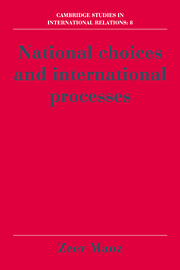Book contents
- Frontmatter
- Contents
- List of figures
- List of tables
- Preface
- 1 Toward a theory of international processes
- 2 Foreign policy decision making: assumptions and characterization of the approach
- 3 The inputs of decision making: identification and conceptualization
- 4 The essential mathematics of inputs
- 5 Models of the decision process
- 6 A formal characterization of decision processes
- 7 A theory of foreign policy decision making
- 8 The analysis of international outcomes
- 9 The evolution of international processes
- 10 Individual preferences, national choices, and international systems
- References
- Name Index
- Subject Index
10 - Individual preferences, national choices, and international systems
Published online by Cambridge University Press: 05 February 2012
- Frontmatter
- Contents
- List of figures
- List of tables
- Preface
- 1 Toward a theory of international processes
- 2 Foreign policy decision making: assumptions and characterization of the approach
- 3 The inputs of decision making: identification and conceptualization
- 4 The essential mathematics of inputs
- 5 Models of the decision process
- 6 A formal characterization of decision processes
- 7 A theory of foreign policy decision making
- 8 The analysis of international outcomes
- 9 The evolution of international processes
- 10 Individual preferences, national choices, and international systems
- References
- Name Index
- Subject Index
Summary
INTRODUCTION
The theory of international processes connects individual preferences, choices, and actions to international politics. It consists of four layers. The first layer explains how individuals form preferences over policy options. The second layer links individual preferences to national choices via collective decision making. The third layer connects the ways nations make choices and the outcomes they get in an interdependent international setting. The fourth layer describes aspects of the evolution of international processes over time.
From the definition of international processes as a chain of temporally related and spatially interdependent intersections of national decisions, it is obvious that the theoretical framework developed herein is of the “bottom-up” type. That is to say, it is a theory in which the whole – the international process – evolves as an aggregation of elements. The theory specifies a causal chain starting with individual traits and perceptions and ending with levels of long-term stability in international interactions. To be sure, the aggregation process is quite complex, for it involves several processes by which inputs are transformed into outputs at each level of analysis. The principal theme of this theory is that complex structures and processes in international politics do not have a life of their own which is independent of and – to a large extent – determines the behavior of the units.
- Type
- Chapter
- Information
- National Choices and International Processes , pp. 531 - 565Publisher: Cambridge University PressPrint publication year: 1990

